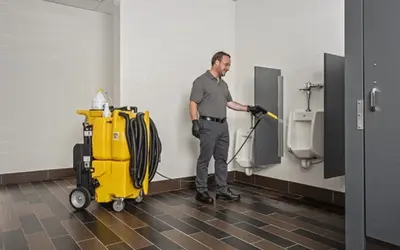Boost Business with Better C-Store Restrooms

The c-store industry is changing rapidly. While classic revenue streams from fuel and tobacco continue to dry up, NACS, the Association for Convenience & Fuel Retailing, reports that foodservice sales are quickly becoming a c-store’s most profitable category.
As these quick roadside stops morph into food and refreshment destinations, convenience store restroom cleanliness becomes vital. Experts agree that customers associate clean c-store restrooms with the overall quality of a store and its ability to deliver food safety.
C-Store Restroom Cleanliness Top Priority
Savvy business owners have taken the message to heart and put restroom cleanliness at the top of their priority list. Don Zietlow, CEO of Kwik Trip, Inc., goes so far as to put his name alongside the restroom complaint hotline number. He tells CPS Daily that he spends an hour each Monday morning personally addressing each complaint!
“When you […] go into the restroom, and the restroom’s not clean, or the outside’s not clean, your perception may be: ‘How clean is the kitchen? How good is the food?’,” said Zietlow in an interview with CPS. “That’s important to me, and it’s also a source of pride with our coworkers.”
Cheeky roadside billboards advertise the comforts awaiting inside the restrooms of Buc-ee’s, a 37-location chain in Texas. A perennial winner of Cintas’ America’s Best Restroom Contest, their Texas-sized restrooms feature top-of-the-line amenities like floor-to-ceiling stall dividers, automated towel dispensers, and an abundance of Purell stations.
However, restroom satisfaction is all about cleanliness and Buc-ee’s guarantees the experience by demanding the staff pay constant attention to cleanliness. “There is literally someone in there all the time,” said company co-owner Arch “Beaver” Aplin, in Texas Monthly Magazine.
Other companies are upping their restroom game as well. Pilot Flying J has put a reported $50 Million into restroom upgrades with amenities like Italian tile accents, LED lighting and low-flow fixtures. Roadrunner Markets even went so far as to create their own, signature bathroom scent.
Cleanliness Isn’t a Gimmick, It’s a Process
While these upgrades are nice, what really matters in convenience store restrooms is cleanliness, particularly if the business is banking on foodservice to boost the bottom line. Cleanliness isn’t a gimmick, design feature, or amenity. If that signature bathroom scent is just covering the smell of old urine, customers will know.
So here’s something disgusting – you know that acrid, burn-your-nostrils urine smell? That’s not actually the smell of urine. It’s the smell of bacteria feasting on the urea in the urine. That’s why it gets stronger over time. That’s also why, in some restrooms, the urine smell never seems to go away. When stubborn smells remain, even after cleaning the fixtures and mopping the floors, that’s because the residue of bacteria and its food – biofilm – never goes away.
Would you use a paintbrush to clean up spilled paint? That process makes about as much sense as mopping. If you did mop with paint, you would see how much gets left behind. Especially in a restroom with tile floors, where every grout line fills with soils as the mop drags across them. With all that biofilm left behind, the restroom will quickly recolonize with bacteria.
Now, instead of the mop, consider a process powered by vacuum removal. This process includes a low-pressure application of chemical, a high-pressure blast of fresh water to break up the biofilm, and then vacuum removal of the soiled solution. This process removes bacteria and its food source to slow recolonizing and keep the restroom cleaner for longer.
See our process for restroom cleaning based on removal.
Related Posts

Cherokee County School District Takes Cleaning into Their Own Hands With Kaivac
Each of the district’s six high schools maintained their restrooms with a No-Touch Cleaning system from Kaivac.
Read more
Grocery Store Cleaning Solutions
Read more